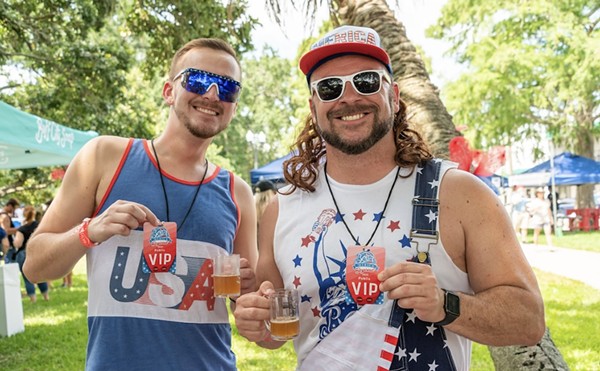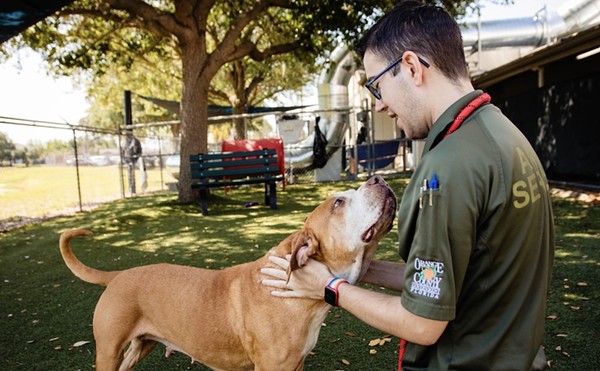When one hears the term "minority," it is usually in reference to African Americans. On a more local level, when talking about minorities or immigrants, people are usually referring to those who trace their roots to Latin America. A group less in the spotlight, however, is Asian Americans, and that's due to a variety of factors. Their numbers are considerably smaller (an estimated 4 percent of the national population and less than 2 percent for Florida), and the term itself is burdened with representing vast cultural and linguistic differences, not to mention the distinction between American-born and foreign-born experiences.
But more and more, Asian Americans are becoming a visible group, whether it is in the glossy ads of magazines or politically minded discussions of the buzz word "diversity." Asian Americans are, after all, the fastest growing minority in Central Florida. Just head down the intersection of Mills Avenue and East Colonial Drive to find evidence in the growing cluster of Vietnamese, Korean and Chinese storefronts. Much more elusive are the stories behind the individuals -- why and how they came to the area, and the values and ideas that they carried with them. Bringing stories to specific faces, "Central Florida Asian American Women: Concepts of Home and Identity," the current exhibit at Crealdé School of Visual Arts, offers Linda Carpenter's intimate look at a cross-section of this growing ethnic group.
The school's compact Community Gallery suits the project well. Visually, it comprises 10 black-and-white photographs set off from the room's stark white walls by silver frames. Each portrait features a woman poised at her home or place of work. Underneath it, along with her name, country of origin and date of immigration, is a short essay that offers a glimpse into her life.
The essays are actually excerpts from longer texts included in a yearlong project by Carpenter, who serves as the director of marketing and communications for the Hamilton Holt School at Rollins College, as well as teaching photography at Crealdé, where her husband is also an instructor. She was able fund this project through a Scholar-Humanist Fellowship Grant she received from the Florida Humanities Council.
Having long possessed an interest in cross-cultural issues, Carpenter's idea for the project partly stemmed from previous work she'd done on the literature of diaspora communities in America. The concepts of self and nation are the threads that weave this exhibit together. The women talk about themselves, their families, their lifestyles and how these were affected by their arrival in America.
Unlike most photography exhibits, the pictures in "Central Florida Asian American Women" are not the main focus; rather, they serve as portals. Each photo helps to visually express the individuality of the woman's identity and experiences, but the project's true strength is in the voices raised in their stories. The magnitude of what each singular image and essay imply is best expressed within the context of the whole. It is compelling to see that all the subjects, though technically the same in racial background and immigrant status, differ as much in appearance as they do in age, occupation and experiences.
A look around the room will attest to Carpenter's efforts to represent diversity. The earliest of the immigrants is a Japanese American woman who came to the United States with her military husband in 1954. The most recent arrival relocated from the People's Republic of China only eight years ago. Some of the women came with their parents as children, while others made the journey with their own families. Careers range from a website developer and cooking teacher to a retired entrepreneur and a recent college graduate.
The woman who most inspired Carpenter's desire to take on this project is pictured sitting at a plain wooden desk; arched chapel windows and a couple of books fill in the otherwise empty room. Christina Nyugen Carbonel, who emigrated from Vietnam with her family in 1980, faces the camera with a peaceful yet pensive look. Carpenter first became friends with Carbonel when she was a student at Rollins, which is, perhaps, why her story takes on such a personal tone. Like most other 20-somethings, Carbonel expresses an inner struggle between what she wants to be and what she feels she should be. This conflict is, however, aggravated by what she perceives as the cultural differences between Vietnam and America.
Like any project dealing in the murkiness of race and gender, generalizations hold a danger all their own. Carpenter's project skillfully avoids such trappings. She'll be the first to admit, though, that this project only skims the surface of what she hopes will be a larger effort.
Indeed, after reading the essays, there were a multitude of questions whizzing around in my head. I wanted to hear more about what it was like to be in an interracial marriage for 13 years before it was constitutionally legal. I wanted to ask the woman who was raised in Spain about the different experience of being an ethnic Chinese in the U.S. In the end, I left with more questions than answers -- though in the case of this project, that is a very positive thing.
What, after all, do these women have in common? Carpenter hesitates to answer, expressing a desire to maintain her subjects' individuality. "They're all hard workers," she concludes. "That, and they love being here."
Linda Carpenter discusses her project in a free program, 6 pm-7 pm Aug. 31 at Crealdé School of Visual Arts.
















